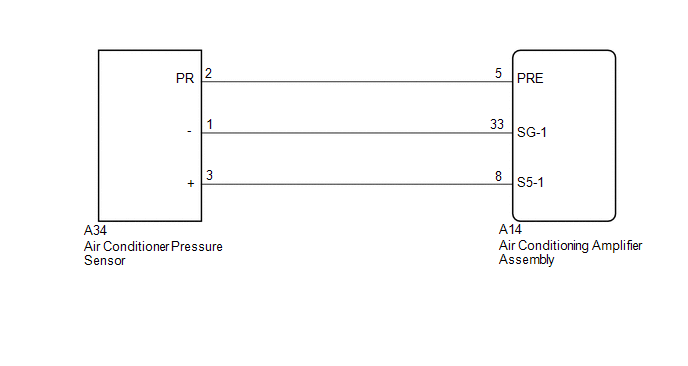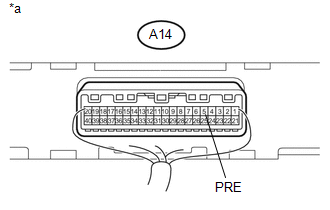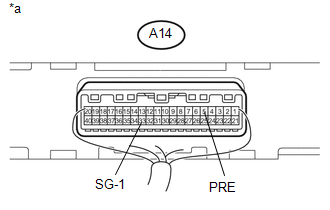Toyota Tacoma (2015-2018) Service Manual: Pressure Sensor Circuit (B1423)
DESCRIPTION
This DTC is stored if refrigerant pressure on the high pressure side is extremely low (176 kPa (1.8 kgf/cm2, 26 psi) or less) or extremely high (3140 kPa (32.0 kgf/cm2, 455 psi) or more). The air conditioner pressure sensor, which is installed on the pipe on the high pressure side to detect refrigerant pressure, sends a refrigerant pressure signal to the air conditioning amplifier assembly. The air conditioning amplifier assembly converts this signal to a pressure value according to the sensor characteristics and uses it to control the compressor.
|
DTC No. |
DTC Detection Condition |
Trouble Area |
|---|---|---|
|
B1423 |
|
|
WIRING DIAGRAM

PROCEDURE
|
1. |
CHECK HARNESS AND CONNECTOR (POWER SOURCE CIRCUIT) |
(a) Disconnect the A34 air conditioner pressure sensor connector.
(b) Measure the voltage according to the value(s) in the table below.
Standard Voltage:
|
Tester Connection |
Switch Condition |
Specified Condition |
|---|---|---|
|
A34-3 (+) - Body ground |
Ignition switch ON |
4.75 to 5.25 V |
| NG | .gif) |
GO TO STEP 5 |
|
|
2. |
CHECK HARNESS AND CONNECTOR (GROUND CIRCUIT) |
(a) Disconnect the A34 air conditioner pressure sensor connector.
(b) Measure the resistance according to the value(s) in the table below.
Standard Resistance:
|
Tester Connection |
Condition |
Specified Condition |
|---|---|---|
|
A34-1 (-) - Body ground |
Always |
Below 1 Ω |
| NG | .gif) |
GO TO STEP 6 |
|
|
3. |
INSPECT AIR CONDITIONING PRESSURE SENSOR (SENSOR SIGNAL CIRCUIT) |
(a) Reconnect the A34 air conditioner pressure sensor connector.
|
(b) Remove the air conditioning amplifier assembly with the connectors
still connected (See page |
|
(c) Measure the voltage according to the value(s) in the table below.
Standard Voltage:
|
Tester Connection |
Switch Condition |
Specified Condition |
|---|---|---|
|
A14-5 (PRE) - Body ground |
Ignition switch ON (A/C: off) |
0.74 to 4.71 V |
|
*a |
Component with harness connected (Air Conditioning Amplifier Assembly) |
HINT:
If the measured voltage is not within the normal range, there may be a malfunction in the air conditioning amplifier assembly, air conditioning pressure sensor, or wire harness. It is also possible that the amount of refrigerant may not be appropriate.
| NG | .gif) |
GO TO STEP 7 |
|
|
4. |
INSPECT AIR CONDITIONING PRESSURE SENSOR (SENSOR SIGNAL CIRCUIT) |
(a) Measure the voltage when the following conditions are satisfied.
|
Item |
Condition |
|---|---|
|
Vehicle Doors |
Fully open |
|
Temperature Setting |
MAX COLD |
|
Blower Speed |
HI |
|
A/C Switch |
On |
|
R/F Switch |
Recirculation |
|
Interior Temperature |
25 to 35°C (77 to 95°F) |
|
Engine Speed |
2000 rpm |
NOTICE:
- If refrigerant pressure on the high pressure side becomes extremely high during the inspection (if the voltage exceeds 4.8 V), the fail-safe function stops compressor operation. Therefore, measure the voltage before the fail-safe operation.
- It is necessary to measure the voltage for a certain amount of time (approximately 10 minutes) because the malfunction may recur after a while.
HINT:
When the outside air temperature is low (below -1.5°C (29.3°F)), the compressor stops due to operation of the ambient temperature sensor and the evaporator temperature sensor to prevent the evaporator from freezing. In this case, perform the inspection in a warm indoor environment.
|
(1) Measure the voltage according to the value(s) in the table below. Standard Voltage:
|
|
|
Result |
Proceed to |
|---|---|
|
OK (When troubleshooting according to the DTC) |
A |
|
OK (When troubleshooting according to Problem Symptoms Table) |
B |
|
NG |
C |
| A | .gif) |
REPLACE AIR CONDITIONING AMPLIFIER ASSEMBLY |
| B | .gif) |
PROCEED TO NEXT SUSPECTED AREA SHOWN IN PROBLEM SYMPTOMS TABLE |
| C | .gif) |
GO TO STEP 13 |
|
5. |
CHECK HARNESS AND CONNECTOR (AIR CONDITIONING AMPLIFIER ASSEMBLY - AIR CONDITIONER PRESSURE SENSOR) |
(a) Reconnect the A34 air conditioner pressure sensor connector.
(b) Disconnect the A14 air conditioning amplifier assembly connector.
(c) Measure the resistance according to the value(s) in the table below.
Standard Resistance:
|
Tester Connection |
Condition |
Specified Condition |
|---|---|---|
|
A34-3 (+) - A14-8 (S5-1) |
Always |
Below 1 Ω |
|
A34-3 (+) or A14-8 (S5-1) - Body ground |
Always |
10 kΩ or higher |
| OK | .gif) |
REPLACE AIR CONDITIONING AMPLIFIER ASSEMBLY |
| NG | .gif) |
REPAIR OR REPLACE HARNESS OR CONNECTOR |
|
6. |
CHECK HARNESS AND CONNECTOR (AIR CONDITIONING AMPLIFIER ASSEMBLY - AIR CONDITIONER PRESSURE SENSOR) |
(a) Reconnect the A34 air conditioner pressure sensor connector.
(b) Disconnect the A14 air conditioning amplifier assembly connector.
(c) Measure the resistance according to the value(s) in the table below.
Standard Resistance:
|
Tester Connection |
Condition |
Specified Condition |
|---|---|---|
|
A34-1 (-) - A14-33 (SG-1) |
Always |
Below 1 Ω |
|
A34-1 (-) or A14-33 (SG-1) - Body ground |
Always |
10 kΩ or higher |
| OK | .gif) |
REPLACE AIR CONDITIONING AMPLIFIER ASSEMBLY |
| NG | .gif) |
REPAIR OR REPLACE HARNESS OR CONNECTOR |
|
7. |
CHECK HARNESS AND CONNECTOR (AIR CONDITIONING AMPLIFIER ASSEMBLY - AIR CONDITIONING PRESSURE SENSOR) |
(a) Reconnect the A34 air conditioner pressure sensor connector.
(b) Disconnect the A14 air conditioning amplifier assembly connector.
(c) Measure the resistance according to the value(s) in the table below.
Standard Resistance:
|
Tester Connection |
Condition |
Specified Condition |
|---|---|---|
|
A34-2 (PR) - A14-5 (PRE) |
Always |
Below 1 Ω |
|
A34-2 (PR) or A14-5 (PRE) - Body ground |
Always |
10 kΩ or higher |
| NG | .gif) |
REPAIR OR REPLACE HARNESS OR CONNECTOR |
|
|
8. |
INSPECT FOR A/C SYSTEM LEAK |
(a) Install a manifold gauge set.
(b) Recover the refrigerant from the A/C system using a refrigerant recovery unit.
(c) Evacuate the A/C system and check that vacuum can be maintained in it.
OK:
Vacuum can be maintained in the A/C system.
HINT:
If vacuum cannot be maintained in the A/C system, refrigerant may be leaking from it. In this case, it is necessary to repair or replace the leaking part of the A/C system.
| NG | .gif) |
GO TO STEP 12 |
|
|
9. |
CHARGE SYSTEM WITH REFRIGERANT |
(a) Use a refrigerant recovery unit to recover refrigerant.
(b) Evacuate the A/C system.
(c) Add an appropriate amount of refrigerant.
- for HFC-134a(R134a) (See page
.gif) )
)
- for HFO-1234yf(R1234yf) (See page
.gif) )
)
HINT:
If refrigerant is added and the system has not been properly evacuated (insufficient vacuum time), moisture in the air remaining in the system will freeze in the cooler expansion valve, blocking the flow on the high pressure side. Therefore, in order to confirm the problem, recover the refrigerant and properly evacuate the system. Add an appropriate amount of refrigerant, and check for DTCs.
|
|
10. |
RECHECK FOR DTC |
(a) Recheck for DTCs when the following conditions are satisfied.
|
Item |
Condition |
|---|---|
|
Vehicle Doors |
Fully open |
|
Temperature Setting |
MAX COLD |
|
Blower Speed |
HI |
|
A/C Switch |
On |
|
R/F Switch |
Recirculation |
|
Interior Temperature |
25 to 35°C (77 to 95°F) |
|
Engine Speed |
2000 rpm |
NOTICE:
If refrigerant pressure on the high pressure side becomes high, the DTC will be set. It is necessary to measure the voltage for a certain amount of time (approximately 10 minutes) because the DTC may be set after the A/C operates for a while.
HINT:
When the outside air temperature is low (below -1.5°C (29.3°F)), the compressor stops due to operation of the ambient temperature sensor and the evaporator temperature sensor to prevent the evaporator from freezing. In this case, perform the inspection in a warm indoor environment.
|
Result |
Proceed to |
|---|---|
|
DTC B1423/23 is output |
A |
|
DTC B1423/23 is not output |
B |
NOTICE:
If the DTC was set due to an insufficient or excessive amount of refrigerant, the problem may have been solved after performing the previous step. However, the root cause of insufficient refrigerant may be refrigerant leaks. The root cause of excessive refrigerant may be adding too much refrigerant when the level was insufficient. Therefore, identify and repair the area where refrigerant leaks from as necessary.
| B | .gif) |
END |
|
|
11. |
INSPECT AIR CONDITIONER PRESSURE SENSOR |
(a) Install a manifold gauge set.
(b) Reconnect the A34 air conditioner pressure sensor connector.
(c) Turn the ignition switch to ON.
|
(d) Measure the voltage according to the value(s) in the table below. Standard Voltage:
|
|
| OK | .gif) |
REPLACE AIR CONDITIONING AMPLIFIER ASSEMBLY |
| NG | .gif) |
REPLACE AIR CONDITIONING PRESSURE SENSOR |
|
12. |
REPAIR A/C SYSTEM LEAK |
(a) Identify the area where refrigerant leaks from.
- for HFC-134a(R134a) (See page
.gif) )
)
- for HFO-1234yf(R1234yf) (See page
.gif) )
)
(b) Repair the identified area of the A/C system.
(c) Evacuate the A/C system.
|
Result |
Proceed to |
|---|---|
|
for HFC-134a(R134a) |
A |
|
for HFO-1234yf(R1234yf) |
B |
| A | .gif) |
CHARGE SYSTEM WITH REFRIGERANT |
| B | .gif) |
CHARGE SYSTEM WITH REFRIGERANT |
|
13. |
INSPECT COOLING FAN SYSTEM |
(a) Check that the cooling fan(s) operates normally.
HINT:
Refer to cooling fan system.
- for 2TR-FE (See page
.gif) )
) - for 2GR-FKS (See page
.gif) )
)
|
Result |
Proceed to |
|---|---|
|
OK |
A |
|
NG (for 2TR-FE) |
B |
|
NG (for 2GR-FKS) |
C |
| B | .gif) |
GO TO COOLING FAN SYSTEM |
| C | .gif) |
GO TO COOLING FAN SYSTEM |
|
|
14. |
CHARGE SYSTEM WITH REFRIGERANT |
(a) Use a refrigerant recovery unit to recover refrigerant.
(b) Evacuate the A/C system.
(c) Add an appropriate amount of refrigerant.
- for HFC-134a(R134a) (See page
.gif) )
)
- for HFO-1234yf(R1234yf) (See page
.gif) )
)
HINT:
If refrigerant is added and the system has not been properly evacuated (insufficient vacuum time), moisture in the air remaining in the system will freeze in the cooler expansion valve, blocking the flow on the high pressure side. Therefore, in order to confirm the problem, recover the refrigerant and properly evacuate the system. Add an appropriate amount of refrigerant, and check for DTCs.
|
|
15. |
RECHECK FOR DTC |
(a) Recheck for DTCs when the following conditions are satisfied.
|
Item |
Condition |
|---|---|
|
Vehicle Doors |
Fully open |
|
Temperature Setting |
MAX COLD |
|
Blower Speed |
HI |
|
A/C Switch |
On |
|
R/F Switch |
Recirculation |
|
Interior Temperature |
25 to 35°C (77 to 95°F) |
|
Engine Speed |
2000 rpm |
NOTICE:
If refrigerant pressure on the high pressure side becomes high, the DTC will be set. It is necessary to measure the voltage for a certain amount of time (approximately 10 minutes) because the DTC may be set after the air conditioning operates for a while.
HINT:
- When the outside air temperature is low (below -1.5°C (29.3°F)), the compressor stops due to operation of the ambient temperature sensor and the evaporator temperature sensor to prevent the evaporator from freezing. In this case, perform the inspection in a warm indoor environment.
- If refrigerant is added and the system has not been properly evacuated (insufficient vacuum time), moisture in the air remaining in the system will freeze in the cooler expansion valve, blocking the flow on the high pressure side. Therefore, in order to confirm the problem, recover the refrigerant and properly evacuate the system. Add an appropriate amount of refrigerant, and check for the DTC. If the DTC is not output after this work, it indicates that the cooler dryer in the cooler condenser assembly is not able to absorb moisture in the refrigerant cycle. It is necessary to replace the cooler dryer in order to complete the repair.
|
Result |
Proceed to |
|---|---|
|
DTC B1423/23 is output |
A |
|
DTC B1423/23 is not output |
B |
| B | .gif) |
REPLACE COOLER CONDENSER ASSEMBLY |
|
|
16. |
REPLACE COOLER EXPANSION VALVE |
(a) Replace the cooler expansion valve with a new one (See page
.gif) ).
).
HINT:
Replace the cooler expansion valve with a new one because the cooler expansion valve is either stuck or clogged.
|
|
17. |
CHARGE SYSTEM WITH REFRIGERANT |
(a) Use a refrigerant recovery unit to recover refrigerant.
(b) Evacuate the A/C system.
(c) Add an appropriate amount of refrigerant.
- for HFC-134a(R134a) (See page
.gif) )
)
- for HFO-1234yf(R1234yf) (See page
.gif) )
)
HINT:
If refrigerant is added and the system has not been properly evacuated (insufficient vacuum time), moisture in the air remaining in the system will freeze in the cooler expansion valve, blocking the flow on the high pressure side. Therefore, in order to confirm the problem, recover the refrigerant and properly evacuate the system. Add an appropriate amount of refrigerant, and check for the DTC.
|
|
18. |
RECHECK FOR DTC |
(a) Recheck for DTCs when the following conditions are satisfied.
|
Item |
Condition |
|---|---|
|
Vehicle Doors |
Fully open |
|
Temperature Setting |
MAX COLD |
|
Blower Speed |
HI |
|
A/C Switch |
On |
|
R/F Switch |
Recirculation |
|
Interior Temperature |
25 to 35°C (77 to 95°F) |
|
Engine Speed |
2000 rpm |
NOTICE:
If refrigerant pressure on the high pressure side becomes high, the DTC will be set. It is necessary to measure the voltage for a certain amount of time (approximately 10 minutes) because the DTC may be set after the air conditioning operates for a while.
HINT:
- When the outside air temperature is low (below -1.5°C (29.3°F)), the compressor stops due to operation of the ambient temperature sensor and the evaporator temperature sensor to prevent the evaporator from freezing. In this case, perform the inspection in a warm indoor environment.
- If refrigerant pressure is not normal after replacing the cooler expansion valve with a new or known good one, the condenser or pipes may be clogged due to dirt, dust or other foreign matter. In this case, clean or replace the cooler condenser assembly or pipes.
|
Result |
Proceed to |
|---|---|
|
DTC B1423/23 is not output |
A |
|
DTC B1423/23 is output |
B |
| A | .gif) |
END |
| B | .gif) |
CLEAN OR REPLACE COOLER CONDENSER ASSEMBLY OR PIPE |
 Ambient Temperature Sensor Circuit (B1412)
Ambient Temperature Sensor Circuit (B1412)
DESCRIPTION
The ambient temperature sensor is installed in front of the condenser to detect
the ambient temperature which is used to control the air conditioning system AUTO
mode. This sensor is ...
 Lost Communication with ECM (U0100,U0142,U0155)
Lost Communication with ECM (U0100,U0142,U0155)
DESCRIPTION
DTC No.
DTC Detecting Condition
Trouble Area
U0100
No communication with ECM
CAN communication system
...
Other materials:
Operation Check
OPERATION CHECK
1. OPERATION DESCRIPTION
(a) Push-button start function:
(1) When the electrical key transmitter sub-assembly is in a detection area inside
the vehicle and the brake pedal is depressed, the engine is started by pressing
the engine switch.
(2) When the electrical key transmitt ...
Intake Air Control Valve Actuator(for Acis)
Components
COMPONENTS
ILLUSTRATION
Inspection
INSPECTION
PROCEDURE
1. INSPECT INTAKE AIR CONTROL VALVE ACTUATOR
(a) Check the operate.
(1) Apply battery voltage to the connector, and check the operation of
the intake air control valve actuator gear.
Text in Illustrati ...
Manual Transmission Oil
Components
COMPONENTS
ILLUSTRATION
On-vehicle Inspection
ON-VEHICLE INSPECTION
PROCEDURE
1. INSPECT MANUAL TRANSMISSION OIL
(a) Park the vehicle on a level surface.
(b) Remove the transmission filler plug and gasket.
(c) Check that the oil level is between 0 to 5 mm (0 to 0 ...

.gif)

